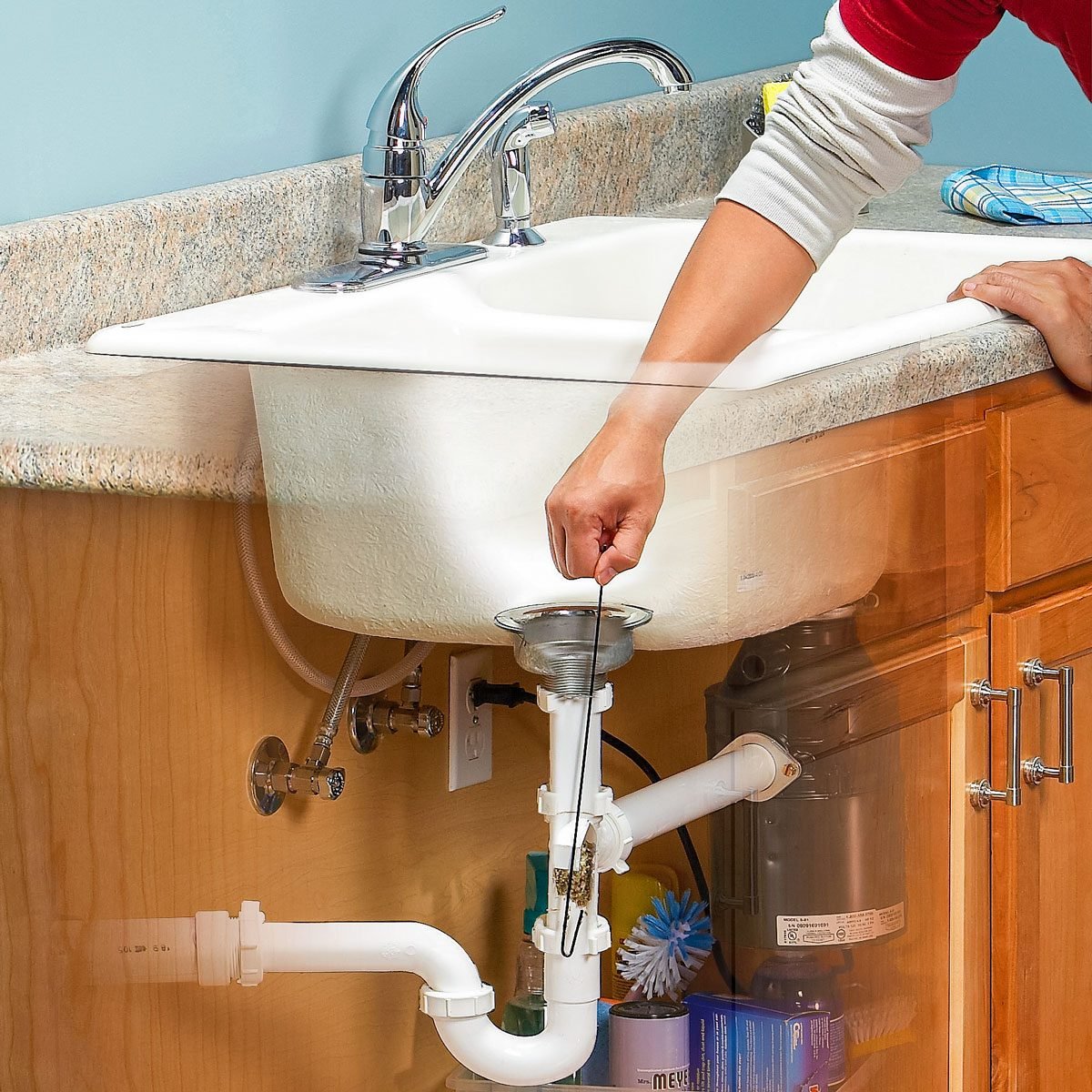How To Unclog a Kitchen Sink
Updated: Sep. 28, 2023
Get your smelly, stopped-up drain running fast again with one of these techniques.
Varies
Beginner
$10 - $40
Introduction
Kitchen sink clogs, usually caused by grease or overworked garbage disposers, can be easily removed in minutes with these simple tools and common-sense tips.Tools Required
- 4-in-1 screwdriver
- Drain Snake (Auger)
- Nippers
- Pliers
- Rags
- Safety glasses
- Slip joint pliers
Materials Required
- Wire coat hanger
When the water in your kitchen sink won’t drain, or drains slowly, don’t reach for the chemical drain cleaner. Instead, try this three-step method recommended by one of our favorite plumbers to unclog a kitchen sink drain.
The first two steps we’ll show you don’t even require removing the trap or take anything apart. If you’re lucky, all you’ll need is a bent coat hanger. But if the clog is in the trap or farther down the drain, you’ll need a 1/4-inch drain snake.
You can buy an inexpensive snake that’s simply a cable running through a bent pipe, but we recommend spending a little more money for a cable enclosed in a drum. This type is much easier to use.
Before you start on any of our solutions, suck all the water out of the sink with a wet-dry shop vacuum or sponge it into a bucket. That lets you see what you’re doing. And if you do have to disassemble plumbing, it’ll be less messy.
Project step-by-step (5)
Snake a drain with a hanger
If you have a two-bowl sink and only one side is clogged, there’s a good chance this fix will work.
First, look under the sink to find the waste tee. If your drain setup looks something like the one shown here and the water backs up on the side without the waste tee, you might remove the clog with a bent coat hanger.
There’s a baffle inside the waste tee meant to direct water down the drain. But since the baffled area is narrower than the rest of the drain, food often gets stuck there. Garbage disposers are notorious for causing clogs, especially at the baffle. The trick is bending a hook on the end of a coat hanger wire and using it to dislodge the clog.
Use a pliers to create a bend that will fit through the slots in the basket strainer. Peek under the sink to get a rough idea how far down the waste tee is from the basket strainer. Push the bent hanger down the drain. Then twist and pull until you feel it hook onto the baffle. Now wiggle it up and down while twisting it to remove the clog.
Run water in the clogged sink to tell if you’ve removed the obstruction. If the sink still doesn’t drain, there’s a clog farther down. Move on to the next step.
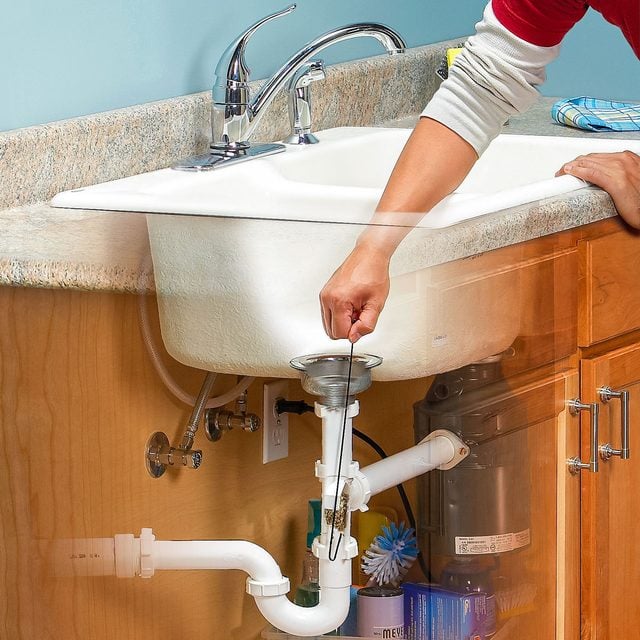
Snake out kitchen sink drain
If the bent coat hanger doesn’t get the clog, there’s a good chance you can still clear it without taking your plumbing apart. Run a modified snake down through the slots in the basket strainer.
First, clip off the spiral end. Then bend the last few inches at about a 30-degree angle with a pliers. Finally, unwind the tip slightly to form a small hook.
There are several advantages to this method. You don’t have to remove all the stuff from under the sink, struggle to take apart and reassemble drains, or worry about spilling dirty drain water when you remove the trap.
Also, pushing the cable down through the basket strainer allows you to clean the slime-covered cable as you withdraw it by running clean water down the drain. (Believe me, this is a nice bonus!) And finally, since the drain is still fully assembled, you can tell by running the kitchen faucet whether you’ve unclogged the drain.
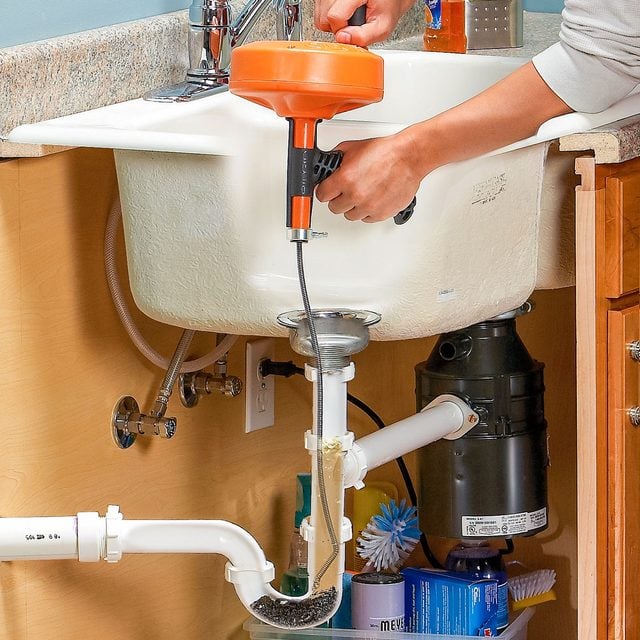
How to avoid a clogged sink
Garbage disposals and grease are the two biggest contributors to clogged sink drains. Here’s the first rule for avoiding clogs: Don’t use your garbage disposals like a trash can. If your family sends vast amounts of food down the disposal, you’ll have a clogged sink someday.
Disposing of turkey carcasses, gummy foods like pasta and fibrous items like banana peels in the sink is asking for trouble. The same goes for heaping plates of leftovers. Scrape the big stuff into the garbage can and use the disposer for the small stuff.
The second rule: Never pour grease down the drain. And running hot water along with it won’t help. The grease will just congeal farther down the drain pipe where it’ll be even harder to clear.
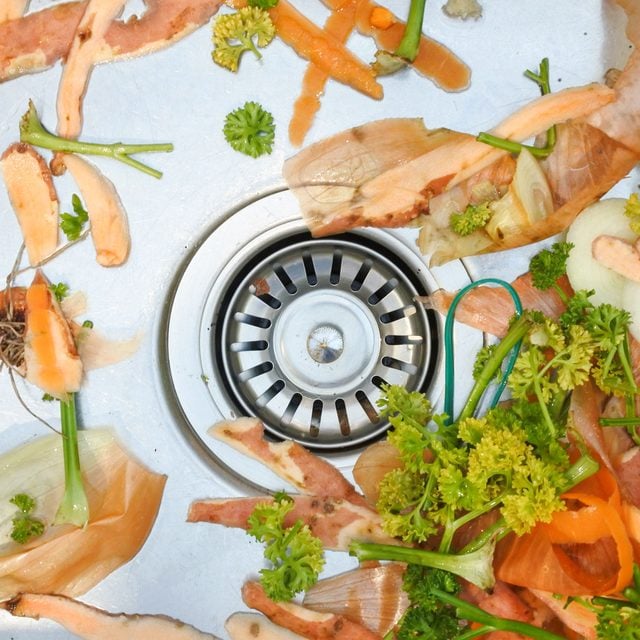
Snake kitchen drain pipe
If you can’t unclog the drain using one of the steps above, then it’s time to take off the P-trap and waste arm and feed the drain snake directly into the drain pipe. Remember to remove as much water from the sink as possible before you remove the trap. Then place a bucket under the trap to catch any remaining water.
Use large slip-joint pliers to loosen the slip-joint nuts on both ends of the trap. Unscrew the nuts and remove the trap. Do the same with the nut that secures the waste arm to the drain and remove the arm.
Before you reach for the drain snake, look up into the baffle tee to make sure the baffle area is clear. Then look into the P-trap to make sure there’s no clog in the bottom. If both spots are clear, then the clog is farther down in the drainpipe and you’ll need a drain snake.
With this method, the only way you’ll know if you’ve unclogged the drain is to reassemble the trap and run water down the drain. If you’ve got a metal trap and drain arm, we recommend replacing them and the other metal drain parts with plastic. Plastic parts are easy to cut and assemble. They’re also easier to take apart if you have a problem in the future, and they don’t corrode.
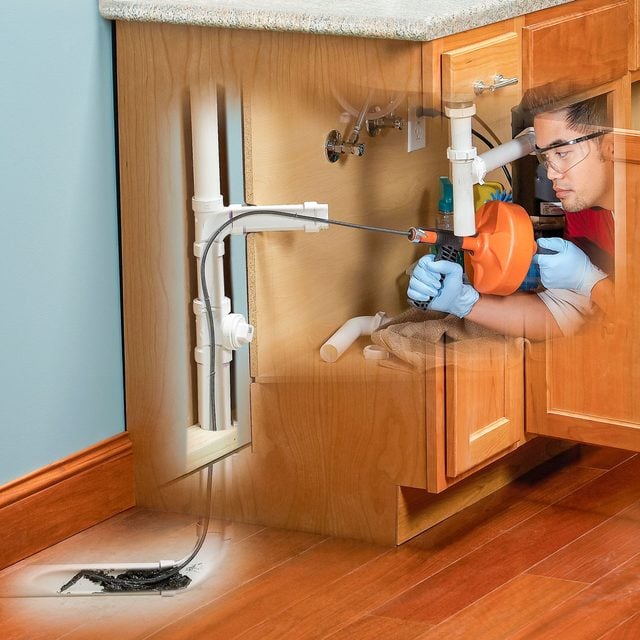
The art of running a snake
There’s an art to using a plumbing snake. The more experience you have, the better you’ll be at it.
Here’s how to do it:
Loosen the setscrew or chuck to allow the cable to come out of the drum freely. Now feed the cable into the drain until you can’t push it any more. It may be stuck on the clog or simply meeting resistance where the drainpipe bends.
Position the end of the drum so there’s about eight inches of cable showing between the drain and the drum, and tighten the setscrew or chuck onto the cable. Withdraw the cable about an inch so it’s free of the obstruction, and start turning the drum while you push it toward the drain. Continue until you’ve pushed the exposed cable down the drain.
Then repeat the process by loosening the setscrew and withdrawing another eight inches of cable. If the end of the cable gets stuck and you keep turning the drum, the cable will start to spiral inside the drain. You want to avoid this, so stop turning the drum if you feel that the cable isn’t turning freely anymore. Withdraw the cable about six inches and try again.
Several things can happen at this point. You might bore through the clog, allowing water to run through and dissolve whatever remains. You might push the clog to a point where the diameter of the pipes is larger and it can wash down the drain. Or you might hook the clog with the end of the snake and pull it out.
This is where your intuition comes into play. When you think you’ve unclogged the drain, withdraw the snake. If you’ve pushed the cable down through the basket strainer, you can rinse it off as you retrieve it by running water. Otherwise, put on some gloves and wipe the cable off with a rag as you push it back into the drum.
When you’re done cleaning the drain, pull the cable out of the drum, rinse it off and wipe it down with an oil-soaked rag to keep it from rusting.
